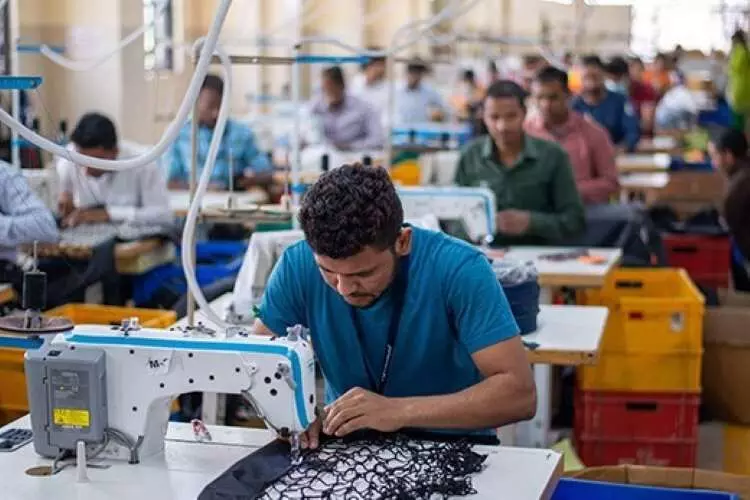Essential Overhaul
Indian economy’s structural vulnerabilities—reflected in trade deficits, increased reliance on the US, lack of innovation and jobless growth—necessitate a revamp in trade and industrial policy

India’s trade deficit increased to USD 94.26 billion in 2024-25 from the previous year’s deficit of USD 78.39 billion. The country’s trade deficit with China reached USD 99 billion in 2024-25, up from USD 85 billion a year ago. In March 2025 alone, imports from China rose by 25 per cent. The surge in Chinese imports was driven by rising demand for electronics, EV batteries, solar cells, and key industrial inputs. As per the Global Trade Research Initiative, China is India’s top supplier in all eight major industrial product categories. India imported USD 113.5 billion worth of goods from China during 2024-25, almost wiping out the USD 118.7 billion remittance the Indians had sent home in 2023-24.
India has emerged as one of the world’s leading recipients of remittances, with a steep rise in inflows from USD 55.6 billion in 2010-11 to USD 118.7 billion in 2023-24. The US emerged as the largest source, accounting for 27.7 per cent of total remittances in 2023-24, up from 23.4 per cent in 2020-21. In 2023-24, India could attract only USD 71.35 billion as foreign direct investment (FDI). In the World Talent Ranking 2024, India ranked 58 globally, with a talent score of 40.47—pushed down two places since the previous year (rank 56) and six places (rank 52) since 2022. A sharp inflow of remittances, coupled with declining talent ranking, suggests that India needs to focus on improving its investment climate and talent development strategies to enhance its competitiveness in the global talent market.
The jobless growth model India has pursued since the 1990s has created many unemployed people in the country. According to economist Amit Bhaduri’s conservative estimate (December 2023), about 11 million people currently enter the labour force every year, with at least 20 million being part of carry-over unemployment from the past. Structural unemployment, which implies that the economy is not generating enough jobs to absorb the growing workforce, is another major cause of concern for India. As these huge unemployed youths don’t find suitable job opportunities in India, they are forced to migrate to other countries.
Make in India: A Failure?
The Modi government’s flagship scheme, Make in India, has failed. Launched in 2014, it aimed to boost the manufacturing sector in India by enhancing existing India-based manufacturing companies and also by attracting investments from other countries by inviting global companies to ‘Make in India’. The share of value addition by the manufacturing sector was 15.9 per cent in 2023-24, compared to 16.7 per cent of GDP (at constant price) in 2013-14.
Again, in 2020, Production-Linked Initiative (PLI) schemes were introduced to boost manufacturing and to compete with China. Around 750 companies signed up to the PLI scheme. Firms were promised cash payouts if they met individual production targets and deadlines. The hope was to raise the share of the manufacturing sector in the economy to 25 per cent by 2025.
As of October 2024, participating firms had produced USD 151.93 billion worth of goods under the programme, only 37 per cent of the target that the government had set. India had issued just USD 1.73 billion in incentives, or less than 8 per cent of the allocated funds, since the plan’s introduction. Manufacturing’s share of the economy has decreased from 15.4 per cent to 14.3 per cent, reports The Hindu.
In 2024, China’s goods exports stood at USD 3.58 trillion, compared to India’s USD 428 billion. Vietnam, despite its smaller size, reached USD 347 billion in exports. In growth terms, Vietnam’s exports have jumped 983 per cent since 2005—much more than India’s 339 per cent growth.
Crisis in Education and Innovation
A study by Abhishek Waghmare reveals that just over one in 10 Indians have a higher education (which includes graduate and post-graduate degrees, or any equivalent programme after the higher secondary level). According to him, “In the early 1990s, India’s higher education enrolment rates were similar to those of China. But in the two decades that followed, China made big strides, and more than seven in 10 young Chinese adults are now in higher education, as compared to three out of ten Indian young adults.”
Analysts observe that India and China took divergent paths in building their future workforces. China banked on structured skill development, deep-tech investment, and a relentless push for merit-based advancement. It paid off. From dominating supply chains to leading in AI and engineering, China’s rise is no accident—it’s a blueprint. But India is still grappling with fragmented policies, bureaucratic red tape, and an education system more attuned to memorisation than innovation.
This difference in approach is reflected in the achievements in innovation. The Global Innovation Index (GII), published by the World Intellectual Property Organisation (WIPO), ranks world economies according to their innovation capabilities. China ranked 11th among the 133 economies featured in the GII 2024, while India ranked 39th.
In terms of R&D expenditure also, China is far ahead of India. Since 2000, China’s R&D investment has surged nearly 18 times to USD 723 billion in 2023. It amounted to 2.6 per cent of China’s GDP. In 2020, India’s R&D expenditure amounted to only 0.6 per cent of India’s GDP.
Urgent Revamp
India must urgently negotiate with China to ensure the protection of its thousands of micro, small, and medium enterprises (MSMEs)—considered as the backbone of the Indian economy—from Chinese imports.
India needs technology to engage millions of unemployed youths to ‘make for India’ to serve its fairly large domestic market. Total reliance on US technology will make the nation completely dependent on a few US companies. From Microsoft to Meta, Apple to Uber, cloud computing to AI, Google to Mastercard, much of the day-to-day technology used by Indians is American. Analysts contemplate that the Trump administration’s attempt to restrict chip exports to China may backfire, potentially boosting Chinese innovation and market share. These restrictions could accelerate China’s chip industry development, ultimately undermining US competitiveness in the global semiconductor market.
Instead of depending fully on the USA, India should explore alternative suppliers. Putting all the eggs in one basket is a risky strategy.
The writer is a professor of Business Administration who primarily writes on political economy, global trade, and sustainable development. Views expressed are personal



